AcF 311 Coursework: Accounting Analysis of Agrico plc
VerifiedAdded on 2023/01/12
|8
|1254
|69
Case Study
AI Summary
This case study analyzes the financial accounting practices of Agrico plc, focusing on two significant transactions: share-based payments to suppliers for goods and share options issued to senior staff. The analysis includes detailed journal entries for recording these transactions, along with the creation of reserve accounts and the allocation of expenses over vesting periods. The study further examines the impact of these transactions on Agrico plc's financial statements, including the income statement and balance sheet, and calculates the effects on Return on Capital Employed (ROCE) and interest cover, highlighting potential breaches of bank covenants. The conclusion emphasizes the implications of these financial decisions on the company's financial health and obligations.
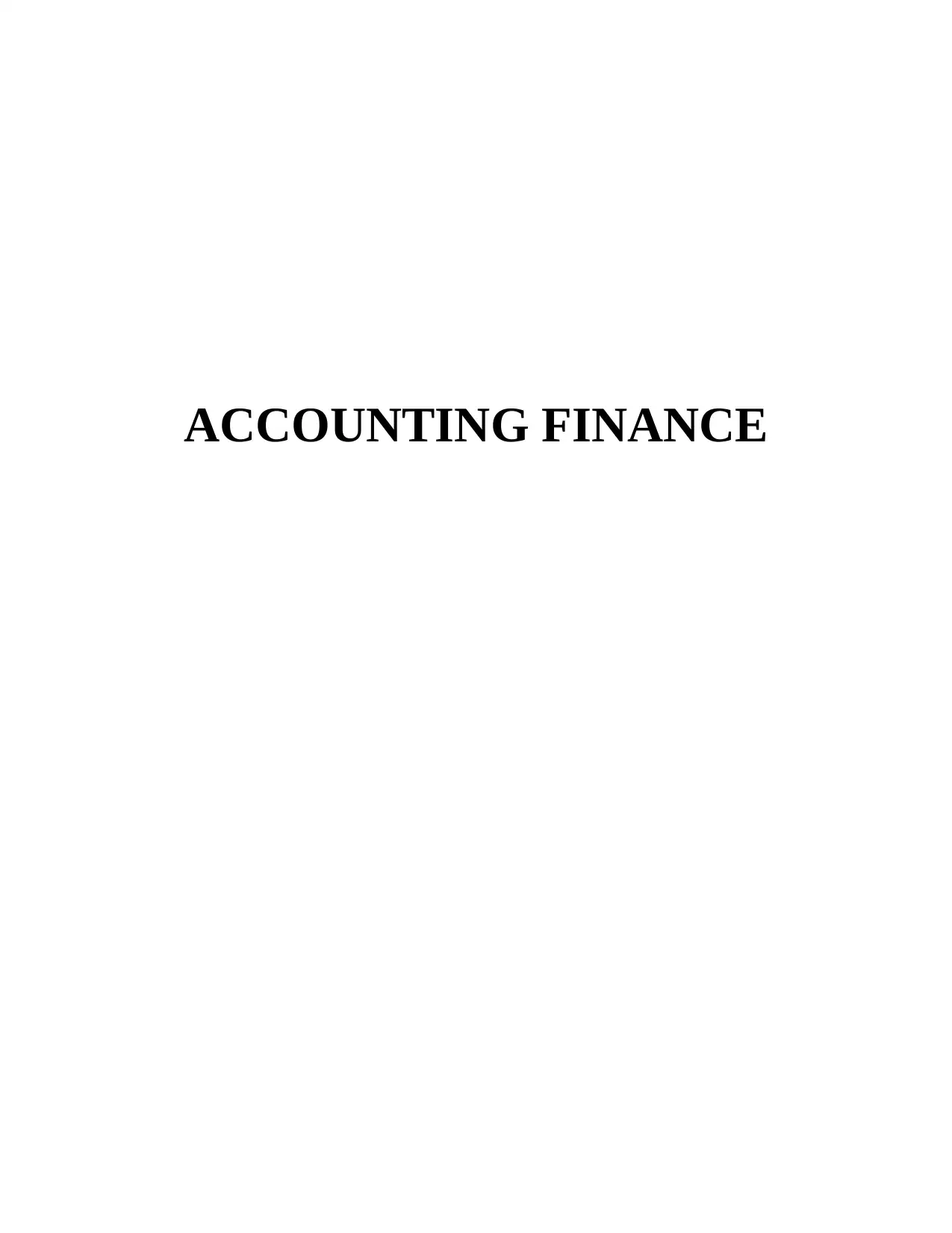
ACCOUNTING FINANCE
Paraphrase This Document
Need a fresh take? Get an instant paraphrase of this document with our AI Paraphraser
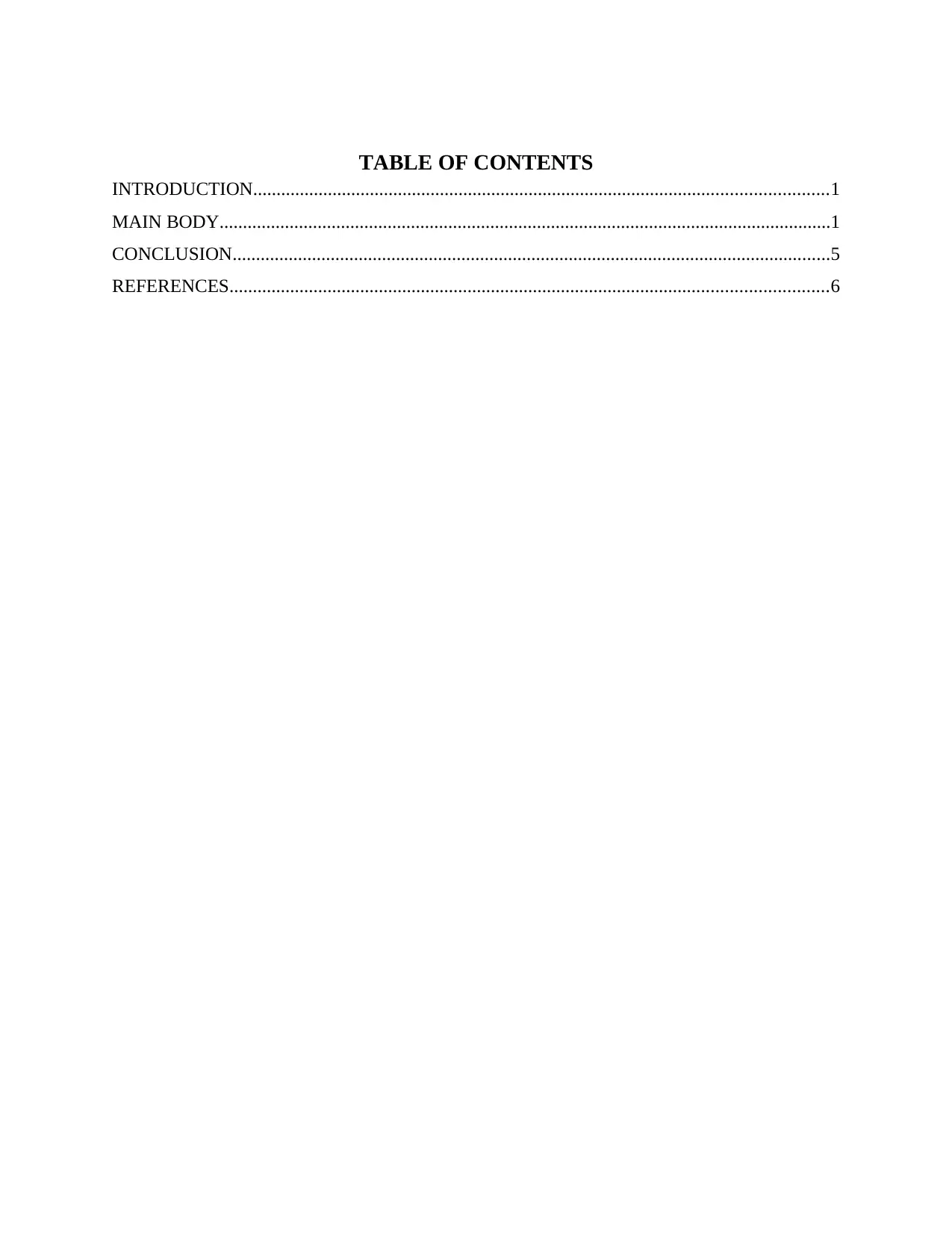
TABLE OF CONTENTS
INTRODUCTION...........................................................................................................................1
MAIN BODY...................................................................................................................................1
CONCLUSION................................................................................................................................5
REFERENCES................................................................................................................................6
INTRODUCTION...........................................................................................................................1
MAIN BODY...................................................................................................................................1
CONCLUSION................................................................................................................................5
REFERENCES................................................................................................................................6
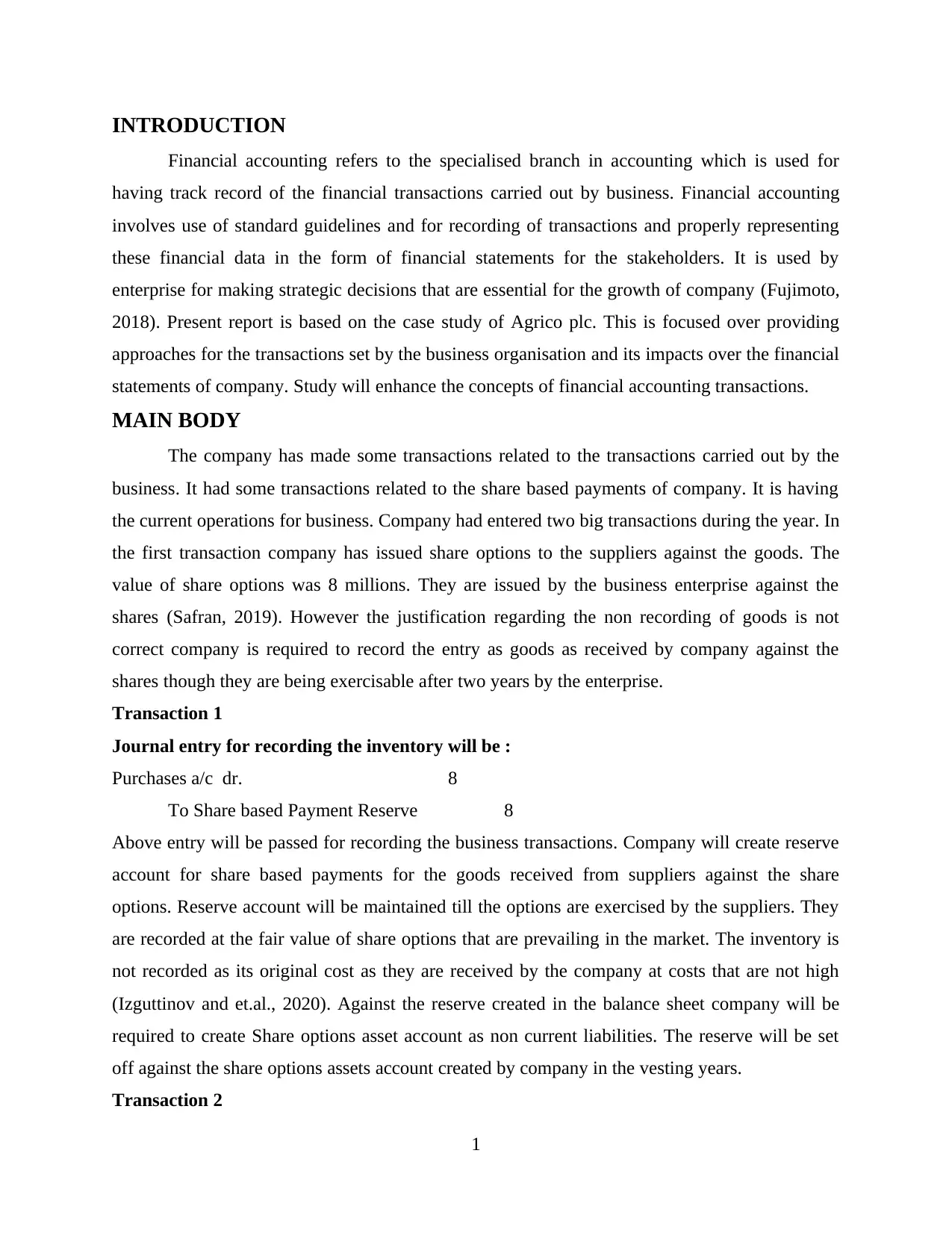
INTRODUCTION
Financial accounting refers to the specialised branch in accounting which is used for
having track record of the financial transactions carried out by business. Financial accounting
involves use of standard guidelines and for recording of transactions and properly representing
these financial data in the form of financial statements for the stakeholders. It is used by
enterprise for making strategic decisions that are essential for the growth of company (Fujimoto,
2018). Present report is based on the case study of Agrico plc. This is focused over providing
approaches for the transactions set by the business organisation and its impacts over the financial
statements of company. Study will enhance the concepts of financial accounting transactions.
MAIN BODY
The company has made some transactions related to the transactions carried out by the
business. It had some transactions related to the share based payments of company. It is having
the current operations for business. Company had entered two big transactions during the year. In
the first transaction company has issued share options to the suppliers against the goods. The
value of share options was 8 millions. They are issued by the business enterprise against the
shares (Safran, 2019). However the justification regarding the non recording of goods is not
correct company is required to record the entry as goods as received by company against the
shares though they are being exercisable after two years by the enterprise.
Transaction 1
Journal entry for recording the inventory will be :
Purchases a/c dr. 8
To Share based Payment Reserve 8
Above entry will be passed for recording the business transactions. Company will create reserve
account for share based payments for the goods received from suppliers against the share
options. Reserve account will be maintained till the options are exercised by the suppliers. They
are recorded at the fair value of share options that are prevailing in the market. The inventory is
not recorded as its original cost as they are received by the company at costs that are not high
(Izguttinov and et.al., 2020). Against the reserve created in the balance sheet company will be
required to create Share options asset account as non current liabilities. The reserve will be set
off against the share options assets account created by company in the vesting years.
Transaction 2
1
Financial accounting refers to the specialised branch in accounting which is used for
having track record of the financial transactions carried out by business. Financial accounting
involves use of standard guidelines and for recording of transactions and properly representing
these financial data in the form of financial statements for the stakeholders. It is used by
enterprise for making strategic decisions that are essential for the growth of company (Fujimoto,
2018). Present report is based on the case study of Agrico plc. This is focused over providing
approaches for the transactions set by the business organisation and its impacts over the financial
statements of company. Study will enhance the concepts of financial accounting transactions.
MAIN BODY
The company has made some transactions related to the transactions carried out by the
business. It had some transactions related to the share based payments of company. It is having
the current operations for business. Company had entered two big transactions during the year. In
the first transaction company has issued share options to the suppliers against the goods. The
value of share options was 8 millions. They are issued by the business enterprise against the
shares (Safran, 2019). However the justification regarding the non recording of goods is not
correct company is required to record the entry as goods as received by company against the
shares though they are being exercisable after two years by the enterprise.
Transaction 1
Journal entry for recording the inventory will be :
Purchases a/c dr. 8
To Share based Payment Reserve 8
Above entry will be passed for recording the business transactions. Company will create reserve
account for share based payments for the goods received from suppliers against the share
options. Reserve account will be maintained till the options are exercised by the suppliers. They
are recorded at the fair value of share options that are prevailing in the market. The inventory is
not recorded as its original cost as they are received by the company at costs that are not high
(Izguttinov and et.al., 2020). Against the reserve created in the balance sheet company will be
required to create Share options asset account as non current liabilities. The reserve will be set
off against the share options assets account created by company in the vesting years.
Transaction 2
1
⊘ This is a preview!⊘
Do you want full access?
Subscribe today to unlock all pages.

Trusted by 1+ million students worldwide
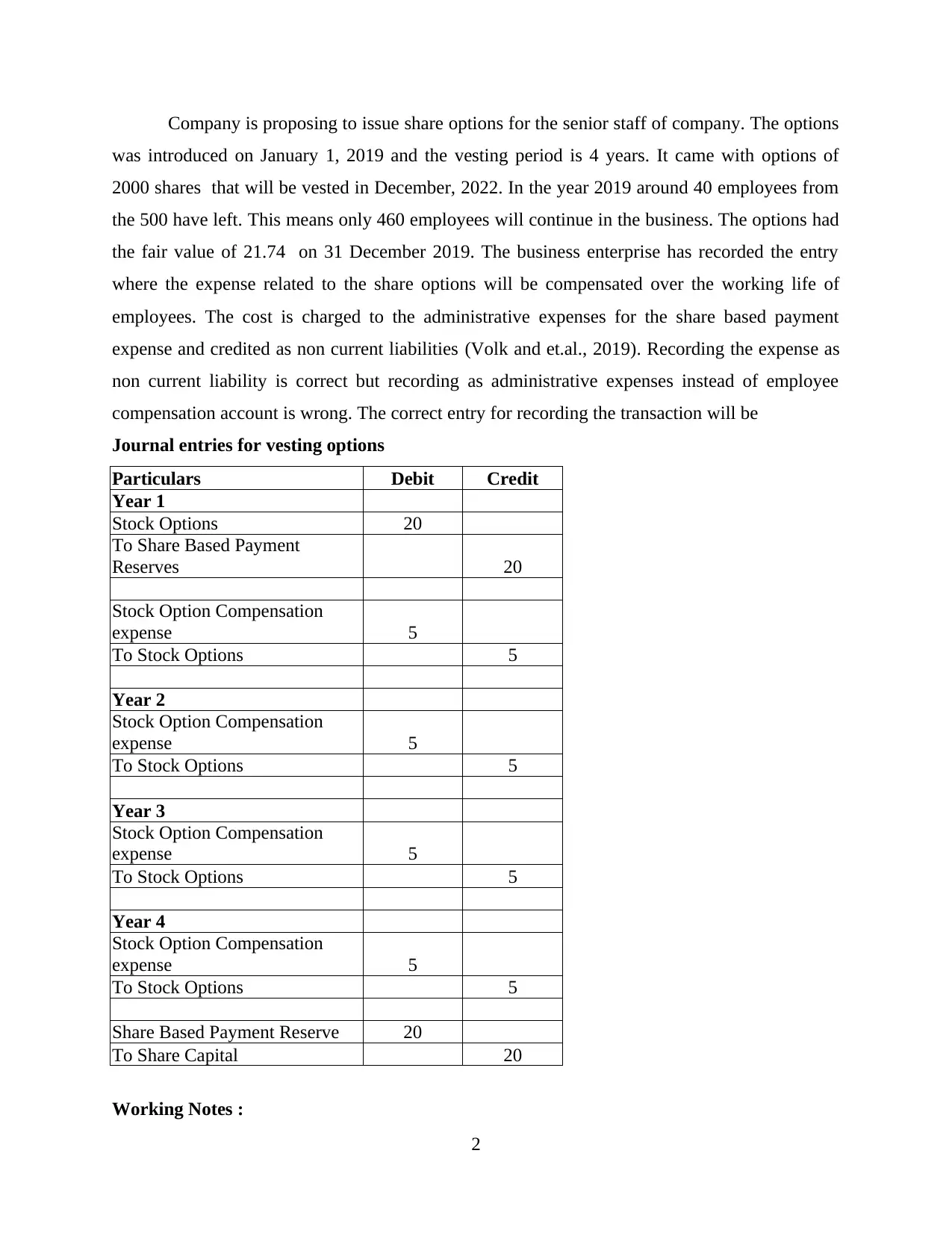
Company is proposing to issue share options for the senior staff of company. The options
was introduced on January 1, 2019 and the vesting period is 4 years. It came with options of
2000 shares that will be vested in December, 2022. In the year 2019 around 40 employees from
the 500 have left. This means only 460 employees will continue in the business. The options had
the fair value of 21.74 on 31 December 2019. The business enterprise has recorded the entry
where the expense related to the share options will be compensated over the working life of
employees. The cost is charged to the administrative expenses for the share based payment
expense and credited as non current liabilities (Volk and et.al., 2019). Recording the expense as
non current liability is correct but recording as administrative expenses instead of employee
compensation account is wrong. The correct entry for recording the transaction will be
Journal entries for vesting options
Particulars Debit Credit
Year 1
Stock Options 20
To Share Based Payment
Reserves 20
Stock Option Compensation
expense 5
To Stock Options 5
Year 2
Stock Option Compensation
expense 5
To Stock Options 5
Year 3
Stock Option Compensation
expense 5
To Stock Options 5
Year 4
Stock Option Compensation
expense 5
To Stock Options 5
Share Based Payment Reserve 20
To Share Capital 20
Working Notes :
2
was introduced on January 1, 2019 and the vesting period is 4 years. It came with options of
2000 shares that will be vested in December, 2022. In the year 2019 around 40 employees from
the 500 have left. This means only 460 employees will continue in the business. The options had
the fair value of 21.74 on 31 December 2019. The business enterprise has recorded the entry
where the expense related to the share options will be compensated over the working life of
employees. The cost is charged to the administrative expenses for the share based payment
expense and credited as non current liabilities (Volk and et.al., 2019). Recording the expense as
non current liability is correct but recording as administrative expenses instead of employee
compensation account is wrong. The correct entry for recording the transaction will be
Journal entries for vesting options
Particulars Debit Credit
Year 1
Stock Options 20
To Share Based Payment
Reserves 20
Stock Option Compensation
expense 5
To Stock Options 5
Year 2
Stock Option Compensation
expense 5
To Stock Options 5
Year 3
Stock Option Compensation
expense 5
To Stock Options 5
Year 4
Stock Option Compensation
expense 5
To Stock Options 5
Share Based Payment Reserve 20
To Share Capital 20
Working Notes :
2
Paraphrase This Document
Need a fresh take? Get an instant paraphrase of this document with our AI Paraphraser
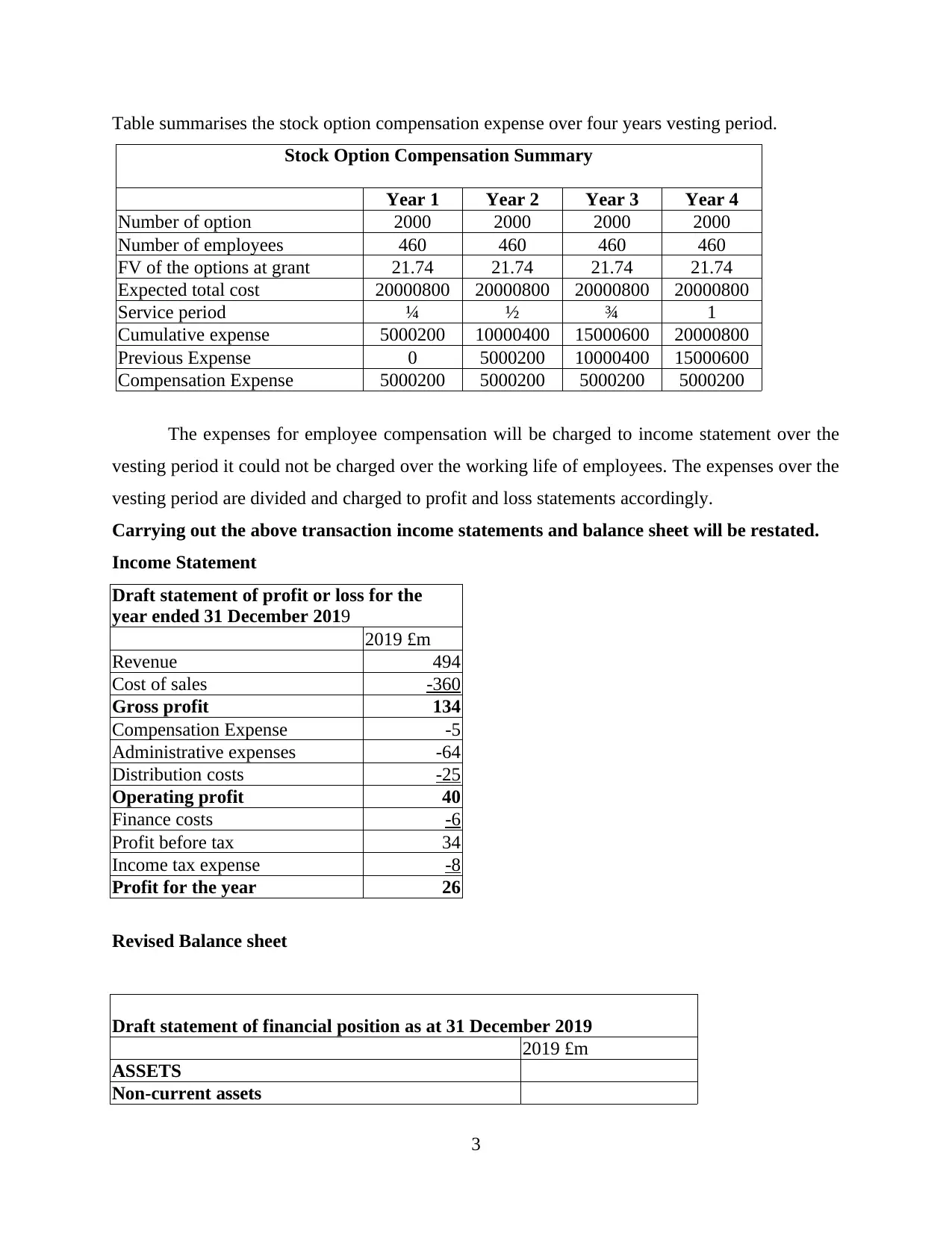
Table summarises the stock option compensation expense over four years vesting period.
Stock Option Compensation Summary
Year 1 Year 2 Year 3 Year 4
Number of option 2000 2000 2000 2000
Number of employees 460 460 460 460
FV of the options at grant 21.74 21.74 21.74 21.74
Expected total cost 20000800 20000800 20000800 20000800
Service period ¼ ½ ¾ 1
Cumulative expense 5000200 10000400 15000600 20000800
Previous Expense 0 5000200 10000400 15000600
Compensation Expense 5000200 5000200 5000200 5000200
The expenses for employee compensation will be charged to income statement over the
vesting period it could not be charged over the working life of employees. The expenses over the
vesting period are divided and charged to profit and loss statements accordingly.
Carrying out the above transaction income statements and balance sheet will be restated.
Income Statement
Draft statement of profit or loss for the
year ended 31 December 2019
2019 £m
Revenue 494
Cost of sales -360
Gross profit 134
Compensation Expense -5
Administrative expenses -64
Distribution costs -25
Operating profit 40
Finance costs -6
Profit before tax 34
Income tax expense -8
Profit for the year 26
Revised Balance sheet
Draft statement of financial position as at 31 December 2019
2019 £m
ASSETS
Non-current assets
3
Stock Option Compensation Summary
Year 1 Year 2 Year 3 Year 4
Number of option 2000 2000 2000 2000
Number of employees 460 460 460 460
FV of the options at grant 21.74 21.74 21.74 21.74
Expected total cost 20000800 20000800 20000800 20000800
Service period ¼ ½ ¾ 1
Cumulative expense 5000200 10000400 15000600 20000800
Previous Expense 0 5000200 10000400 15000600
Compensation Expense 5000200 5000200 5000200 5000200
The expenses for employee compensation will be charged to income statement over the
vesting period it could not be charged over the working life of employees. The expenses over the
vesting period are divided and charged to profit and loss statements accordingly.
Carrying out the above transaction income statements and balance sheet will be restated.
Income Statement
Draft statement of profit or loss for the
year ended 31 December 2019
2019 £m
Revenue 494
Cost of sales -360
Gross profit 134
Compensation Expense -5
Administrative expenses -64
Distribution costs -25
Operating profit 40
Finance costs -6
Profit before tax 34
Income tax expense -8
Profit for the year 26
Revised Balance sheet
Draft statement of financial position as at 31 December 2019
2019 £m
ASSETS
Non-current assets
3
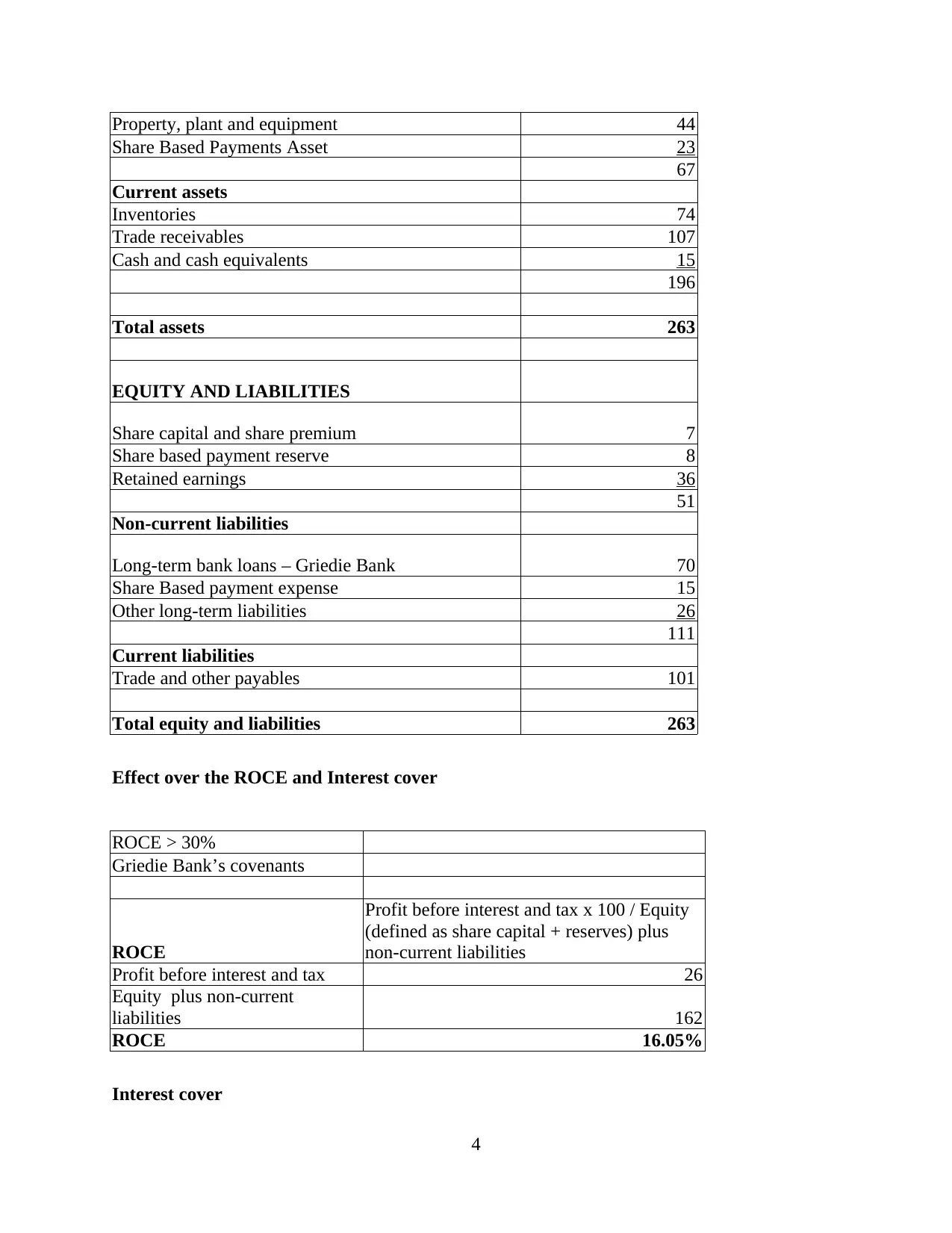
Property, plant and equipment 44
Share Based Payments Asset 23
67
Current assets
Inventories 74
Trade receivables 107
Cash and cash equivalents 15
196
Total assets 263
EQUITY AND LIABILITIES
Share capital and share premium 7
Share based payment reserve 8
Retained earnings 36
51
Non-current liabilities
Long-term bank loans – Griedie Bank 70
Share Based payment expense 15
Other long-term liabilities 26
111
Current liabilities
Trade and other payables 101
Total equity and liabilities 263
Effect over the ROCE and Interest cover
ROCE > 30%
Griedie Bank’s covenants
ROCE
Profit before interest and tax x 100 / Equity
(defined as share capital + reserves) plus
non-current liabilities
Profit before interest and tax 26
Equity plus non-current
liabilities 162
ROCE 16.05%
Interest cover
4
Share Based Payments Asset 23
67
Current assets
Inventories 74
Trade receivables 107
Cash and cash equivalents 15
196
Total assets 263
EQUITY AND LIABILITIES
Share capital and share premium 7
Share based payment reserve 8
Retained earnings 36
51
Non-current liabilities
Long-term bank loans – Griedie Bank 70
Share Based payment expense 15
Other long-term liabilities 26
111
Current liabilities
Trade and other payables 101
Total equity and liabilities 263
Effect over the ROCE and Interest cover
ROCE > 30%
Griedie Bank’s covenants
ROCE
Profit before interest and tax x 100 / Equity
(defined as share capital + reserves) plus
non-current liabilities
Profit before interest and tax 26
Equity plus non-current
liabilities 162
ROCE 16.05%
Interest cover
4
⊘ This is a preview!⊘
Do you want full access?
Subscribe today to unlock all pages.

Trusted by 1+ million students worldwide
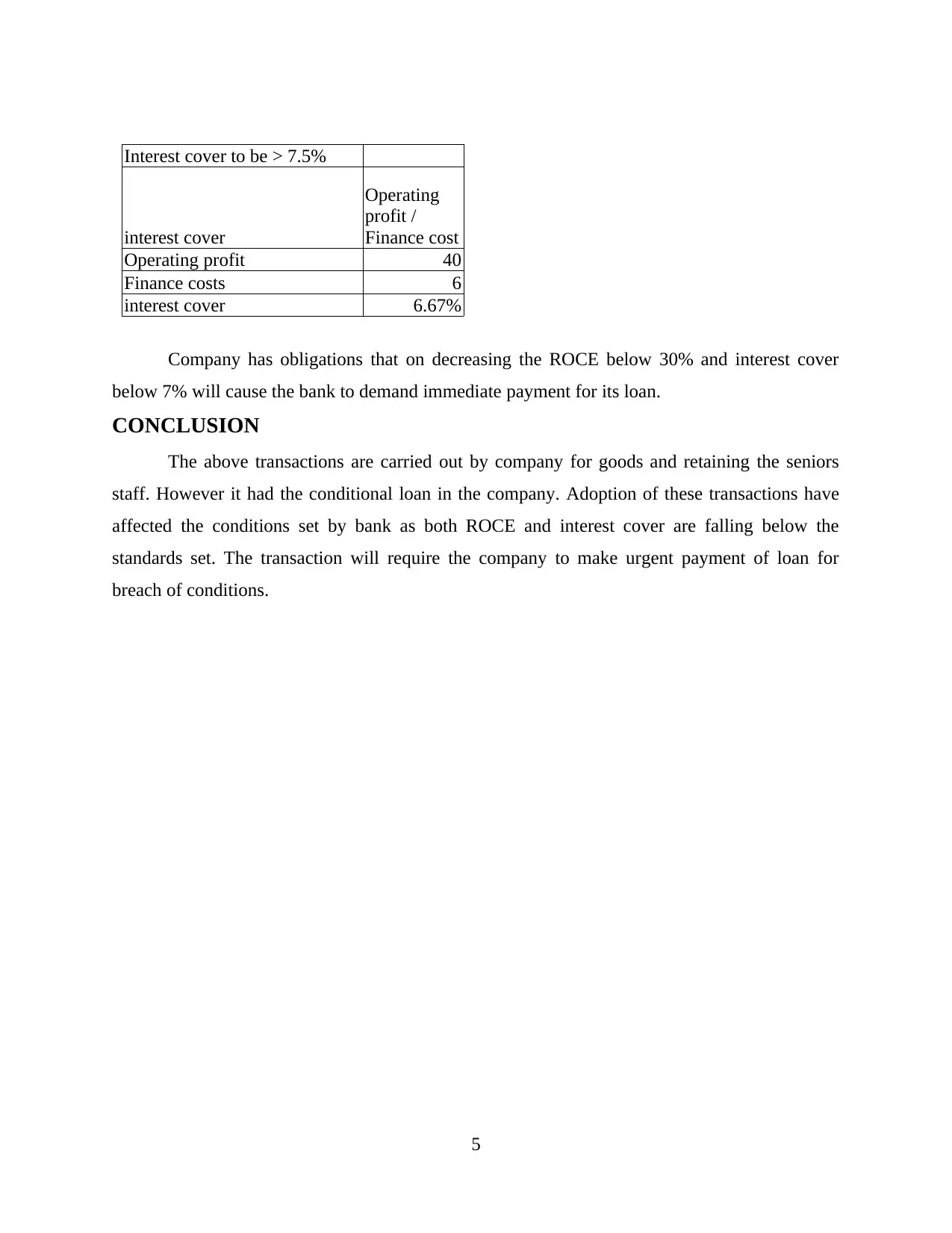
Interest cover to be > 7.5%
interest cover
Operating
profit /
Finance cost
Operating profit 40
Finance costs 6
interest cover 6.67%
Company has obligations that on decreasing the ROCE below 30% and interest cover
below 7% will cause the bank to demand immediate payment for its loan.
CONCLUSION
The above transactions are carried out by company for goods and retaining the seniors
staff. However it had the conditional loan in the company. Adoption of these transactions have
affected the conditions set by bank as both ROCE and interest cover are falling below the
standards set. The transaction will require the company to make urgent payment of loan for
breach of conditions.
5
interest cover
Operating
profit /
Finance cost
Operating profit 40
Finance costs 6
interest cover 6.67%
Company has obligations that on decreasing the ROCE below 30% and interest cover
below 7% will cause the bank to demand immediate payment for its loan.
CONCLUSION
The above transactions are carried out by company for goods and retaining the seniors
staff. However it had the conditional loan in the company. Adoption of these transactions have
affected the conditions set by bank as both ROCE and interest cover are falling below the
standards set. The transaction will require the company to make urgent payment of loan for
breach of conditions.
5
Paraphrase This Document
Need a fresh take? Get an instant paraphrase of this document with our AI Paraphraser
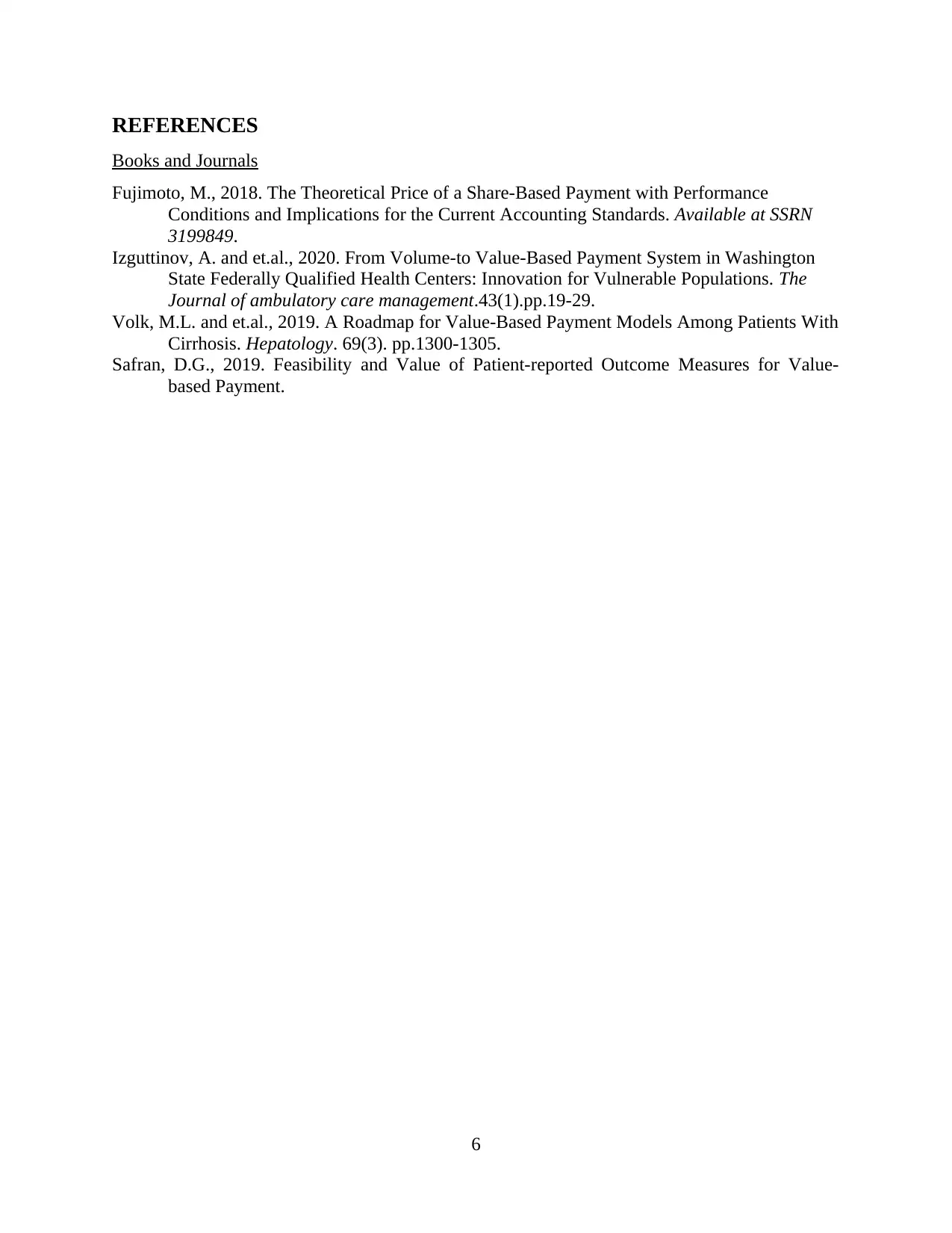
REFERENCES
Books and Journals
Fujimoto, M., 2018. The Theoretical Price of a Share-Based Payment with Performance
Conditions and Implications for the Current Accounting Standards. Available at SSRN
3199849.
Izguttinov, A. and et.al., 2020. From Volume-to Value-Based Payment System in Washington
State Federally Qualified Health Centers: Innovation for Vulnerable Populations. The
Journal of ambulatory care management.43(1).pp.19-29.
Volk, M.L. and et.al., 2019. A Roadmap for Value‐Based Payment Models Among Patients With
Cirrhosis. Hepatology. 69(3). pp.1300-1305.
Safran, D.G., 2019. Feasibility and Value of Patient-reported Outcome Measures for Value-
based Payment.
6
Books and Journals
Fujimoto, M., 2018. The Theoretical Price of a Share-Based Payment with Performance
Conditions and Implications for the Current Accounting Standards. Available at SSRN
3199849.
Izguttinov, A. and et.al., 2020. From Volume-to Value-Based Payment System in Washington
State Federally Qualified Health Centers: Innovation for Vulnerable Populations. The
Journal of ambulatory care management.43(1).pp.19-29.
Volk, M.L. and et.al., 2019. A Roadmap for Value‐Based Payment Models Among Patients With
Cirrhosis. Hepatology. 69(3). pp.1300-1305.
Safran, D.G., 2019. Feasibility and Value of Patient-reported Outcome Measures for Value-
based Payment.
6
1 out of 8
Related Documents
Your All-in-One AI-Powered Toolkit for Academic Success.
+13062052269
info@desklib.com
Available 24*7 on WhatsApp / Email
![[object Object]](/_next/static/media/star-bottom.7253800d.svg)
Unlock your academic potential
Copyright © 2020–2025 A2Z Services. All Rights Reserved. Developed and managed by ZUCOL.



